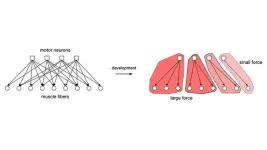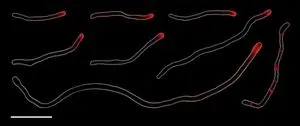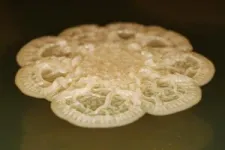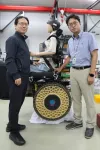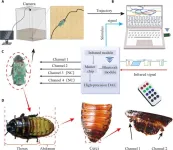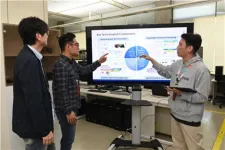(Press-News.org) When you ask a rideshare app to find you a car, the company’s computers get to work. They know you want to reach your destination quickly. They know you’re not the only user who needs a ride. And they know drivers want to minimize idle time by picking up someone nearby. The computer’s job, says Cold Spring Harbor Laboratory Associate Professor Saket Navlakha, is to pair drivers with riders in a way that maximizes everyone’s happiness.
Computer scientists like Navlakha call this bipartite matching. It’s the same task handled by systems pairing organ donors with transplant candidates, medical students with residency programs, and advertisers with ad slots. As such, it’s the subject of intense study.
“This is probably one of the 10 most famous problems in computer science," says Navlakha.
Now, he’s found a way to do it better by taking a cue from biology. Navlakha recognized a bipartite matching problem in the wiring of the nervous system. In adult animals, each of the body’s muscle fibers is paired with exactly one neuron that controls its movement. However, early in life, every fiber is targeted by many neurons. To get an animal moving efficiently, excess connections must be pruned. So, which matches are made to last?
The nervous system has an efficient solution. Navlakha explains that neurons initially connected to the same muscle fiber compete against each other to maintain their match, using neurotransmitters as “bidding” resources. Neurons that lose this biological auction can take their neurotransmitters and bid on other fibers. This way, every neuron and fiber eventually winds up with a partner.
Navlakha devised a way to implement this matching strategy outside the nervous system. “It’s a simple algorithm,” he says. “It’s only two equations. One is the competition between neurons connected to the same fiber, and two is the reallocation of resources.”
Tested against the best bipartite matching programs out there, the neuroscience-inspired algorithm performs very well. It creates near-optimal pairings and leaves fewer parties unmatched. In everyday applications, that could mean shorter wait times for rideshare passengers and fewer hospitals without medical residents.
Navlakha points out another advantage. The new algorithm preserves privacy. Most bipartite matching systems require that pertinent information be relayed to a central server for processing. But in many cases—from online auctions to donor organ matching—a distributed approach may be preferred. With countless potential applications, Navlakha hopes others will adapt the new algorithm for tools of their own.
“It’s a great example of how studying neural circuits can reveal new algorithms for important AI problems,” he adds.
END
The nervous system’s matchmaker
2024-09-02
ELSE PRESS RELEASES FROM THIS DATE:
Open Wide: Human Mouth Bacteria Reproduce through Rare Form of Cell Division
2024-09-02
By Emily Greenhalgh
One of the most diverse ecosystems on the planet is closer than you think — right inside your mouth. Your mouth is a thriving ecosystem of more than 500 different species of bacteria living in distinct, structured communities called biofilms. Nearly all of these bacteria grow by splitting [or dividing] into two, with one mother cell giving rise to two daughter cells.
New research from the Marine Biological Laboratory (MBL) and ADA Forsyth uncovered an extraordinary mechanism of cell division in Corynebacterium matruchotii, one of the most common bacteria living in dental plaque. ...
KIMM develops wheel that alters stiffness in real time based on situation
2024-09-02
A new technology for wheels and mobile systems, necessary for overcoming various obstacles in daily life such as stairs or rocks by adjusting the stiffness of the wheel in real time, has been developed for the first time in the world. This noble technology is anticipated to find wide applications in various moving vehicles equipped with wheels, where overcoming terrain obstacles is essential.
The Korea Institute of Machinery and Materials (President Seog-Hyeon Ryu, hereinafter referred to as KIMM), an institute under the jurisdiction of the ...
Blood stem cell breakthrough could transform bone marrow transplants
2024-09-02
Melbourne researchers have made a world first breakthrough into creating blood stem cells that closely resemble those in the human body. And the discovery could soon lead to personalised treatments for children with leukaemia and bone marrow failure disorders.
The research, led by Murdoch Children’s Research Institute (MCRI) and published in Nature Biotechnology, has overcome a major hurdle for producing human blood stem cells, which can create red cells, white blood cells and platelets, that closely match those in the human embryo.
MCRI Associate Professor Elizabeth Ng said the team had made a significant discovery in human blood stem ...
Rare genetic variants linked to bicuspid aortic valve disease in young adults identified by UTHealth Houston researchers
2024-09-02
Genetic variants linked to a rare form of bicuspid aortic valve disease that affects young adults and can lead to dangerous and potentially life-threatening aortic complications have been identified by researchers at UTHealth Houston.
The study was published today in the American Journal of Human Genetics.
“We previously found that young individuals who present due to early onset thoracic aortic dissections are more likely to have bicuspid aortic valves and more likely to have rare variants in bicuspid aortic valve-associated genes,” said Siddharth Prakash, MD, PhD, co-principal investigator of the study and associate professor of medical ...
Locomotion control of cyborg insects by charge-balanced biphasic electrical stimulation
2024-09-02
A research paper by scientists at Beijing Institute of Technology proposed a universal system for remote signal output control using infrared signals.
The new research paper, published on Jul. 05 in the journal Cyborg and Bionic Systems, proposed a system that integrates high-precision digital-to-analog converters capable of generating customized waveform electrical stimulation signals within defined ranges. This enhances the accuracy of locomotion control in cyborg insects while maintaining real-time control and dynamic parameter adjustment. The proposed system is verified by experiments.
The integration of electronic stimulation devices with insects in ...
Depressed adolescents twice as likely to vape
2024-09-02
A study on vaping behaviour among Australian high school students has found those who reported severe depressive symptoms were over twice as likely to have tried e-cigarettes, compared to those reporting no depressive symptoms.
Data showed overall higher e-cigarette use among those with poorer mental health, including severe depressive symptoms, moderate and high stress, and low wellbeing.
The findings show a critical need for effective mental health support at the same time as vaping prevention during early adolescence -- when these issues first emerge.
The researchers surveyed over ...
Helping public decision-making with AI-based policy intelligence system
2024-09-02
Korean researchers are pushing for a new AI-based policy intelligence research project that can assist the public decision-making and policy execution of domestic and foreign local governments.
Electronics and Communications Research Institute (ETRI) announced on July 1 that they have decided to establish a cooperative system with the International Institute for Applied Systems Analysis (IIASA)1) to conduct further research regarding the development of an AI policy intelligence system that can assist public policy decision-making.
1) International Institute for Applied Systems Analysis (IIASA): An independent international research institute located ...
Pulmonary vein isolation vs sham intervention in symptomatic atrial fibrillation
2024-09-02
About The Study: Pulmonary vein isolation resulted in a statistically significant and clinically important decrease in atrial fibrillation burden at 6 months, with substantial improvements in symptoms and quality of life, compared with a sham procedure.
Corresponding Authors: To contact the corresponding authors, email Rick A. Veasey, MD, (rick.veasey@nhs.net) and Rajdip Dulai, MBBS, (rajdip.dulai.21@ucl.ac.uk)
To access the embargoed study: Visit our For The Media website at this link https://media.jamanetwork.com/
(doi:10.1001/jama.2024.17921)
Editor’s ...
Lesion-level effects of LDL-C–lowering therapy in patients with acute myocardial infarction
2024-09-02
About The Study: At the lesion level, very intensive lipid-lowering therapy induced substantially greater percent atheroma volume regression than described in previous vessel-level analyses. Compared with statin therapy alone, alirocumab treatment was associated with greater enlargement of the lesion minimum lumen area and more frequent transition of presumably high-risk plaque phenotypes into more stable, less lipid-rich plaque phenotypes.
Corresponding Author: To contact the corresponding author, Lorenz ...
How cells control gene expression by cleaning up their mistakes
2024-09-02
Alternative splicing is a genetic process where different segments of genes are removed, and the remaining pieces are joined together during transcription to messenger RNA (mRNA). This mechanism increases the diversity of proteins that can be generated from genes, by assembling sections of genetic code into different combinations. This is believed to enhance biological complexity by allowing genes to produce different versions of proteins, or protein isoforms, for many different uses.
New research from the University of Chicago suggests that alternative splicing may have an even greater influence on biology than just by creating new protein isoforms. The ...
